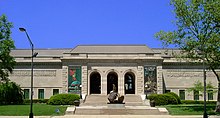Richards, McCarty & Bulford


Richards, McCarty & Bulford was an American architectural firm. The General Services Administration has called the firm the "preeminent" architectural firm of the city of Columbus, Ohio.[1] A number of the firm's works are listed on the National Register of Historic Places.[2] The firm operated until 1943.[3]
History
[edit]Clarence Earl Richards (1864–1921) and Joel Edward McCarty (1856–1952) founded the firm as Richards & McCarty in 1898, Columbus, Ohio. George Henry Bulford (1870–1942) joined as partner in 1899 and the firm name became Richards, McCarty & Bulford. Richards, McCarty, and Bulford had previously apprenticed at the firm of Yost & Packard of Columbus. By way of McCarty's mother, Mary McCarty (née Mary Yost; 1834–1893), McCarty was a nephew of Joseph W. Yost.
The firm was in business until 1943.[3]
Works
[edit]Tennessee
[edit]- The Burwell, 602 S. Gay St., Knoxville, Tennessee, NRHP-listed[2]
Indiana
[edit]- Anderson Center for the Arts, 32 W. 10th St., Anderson, Indiana, NRHP-listed[2]
- Grant County Jail and Sheriff's Residence, 215 E. 3rd St., Marion, Indiana, NRHP-listed[2]
- Part of the Marion Downtown Commercial Historic District, Marion, Indiana, NRHP-listed[2]
Ohio
[edit]Columbus
[edit]- American Education Press Building, 400 S. Front St.
- Athletic Club of Columbus, 136 East Broad St.[3]
- Central Union Telephone Building, 33 N. Third St.[4]
- Citizens Building, 51 N. High St., NRHP-listed[3]
- Columbus Museum of Art, 480 E. Broad St., NRHP-listed[2][3]
- Frederick A. Miller House, 2065 Barton Pl. & 140 Park Dr., NRHP-listed[2]
- Hartman Building and Theater, State and Third streets
- Johnson-Campbell House, 1203 E. Broad St., NRHP-listed[2]
- Joseph P. Kinneary United States Courthouse, 85 Marconi Blvd.[1][3]
- Knights of Columbus Building[3]
- Lazarus Building, 141 S. High St.[3]
- Ohio Institution for the Education of the Deaf and Dumb, 408 E. Town St., NRHP-listed[2][3]
- Ohio National Bank, 167 S. High St., NRHP-listed[2][3]
- South High School, 1160 Ann St.
- St. Joseph Cathedral alterations[3]
- White-Haines Building, 82 N. High St.[5][3]
Elsewhere in Ohio
[edit]- Eldridge-Higgins Building, 525 Orange St., Coshocton, Ohio, NRHP-listed[2]
- Hardin County Courthouse, Courthouse Sq., Kenton, Ohio, NRHP-listed[2][3]
- Kenton Public Library, 121 N. Detroit Street, Kenton, Ohio[3]
- Lawrence County Courthouse (Ironton, Ohio) NRHP-listed
- Marting Hotel, 202 Park Av., Ironton, Ohio, NRHP-listed[2]
- Frank Huber Residence, 416 East Church Street and Greenwood Street, Marion, Ohio.
Kentucky
[edit]- Eleventh District School, Parkway and Altamont St., Covington, Kentucky, NRHP-listed[2]
- Lexington City National Bank Building, 259-265 W. Main St., Lexington, Kentucky, NRHP-listed[2]
Kansas
[edit]Wichita
[edit]- The Schweiter Building – at Main Street and Doublas Avenue, complete around 1910, Henry S. Schweiter Jr. (1876–1948), proprietor
- The Wichita Forum, completed 1911, was, at the time, the largest convention facility in Kansas. The financing was sponsored by the city of Wichita
- The Hotel Lassen (aka Market Centre), built in 1918, Henry Lassen (1861–1919), proprietor (NRHP Information System #84000108, October 4, 1984)
- The Wheeler-Kelly-Hagney building – 120 South Market Street, was built in 1920. The founding officers of Wheeler, Kelly, Hagney Trust Company were Howard Victor Wheeler (1874–1951), Harry Johnston Hagney (1865–1931), John Clark Kelly (1872–1956), and Henry Harrison Dewey (1841–1916) – all members of a real estate firm (NRHP Information System ID: #82002671, March 11, 1982)
- Wesley Hospital, dedicated September 19, 1921
- The First National Bank Building, at 105 North Main Street, opened in 1921 (northwest corner of Main Street and Douglas Avenue), caddy corner to the Beacon building; George H. Bulford was the architect.
Selected architects
[edit]The three firm name-sake architects all had worked at Yost & Packard in Columbus:
- C.E. Richards (né Clarence Earl Richards; 1864–1921), charter member of the Columbus, Ohio, chapter of the American Institute of Architects
- J.E. McCarty (né Joel Edward McCarty; 1856–1952)
- George Henry Bulford (1870–1942)
See also
[edit]References
[edit]- ^ a b GSA site
- ^ a b c d e f g h i j k l m n o "National Register Information System". National Register of Historic Places. National Park Service. July 9, 2010.
- ^ a b c d e f g h i j k l m n "National Register of Historic Places Registration Form". National Park Service. Retrieved March 16, 2023.
- ^ https://columbusunderground.com/renovation-planned-for-historic-downtown-building-bw1/ [bare URL]
- ^ Darbee, Jeffrey T.; Recchie, Nancy A. (2008). The AIA Guide to Columbus. Ohio University Press. ISBN 9780821416846.
External links
[edit]- Richards, McCarty & Bulford collection, at Ohio State University KSA
